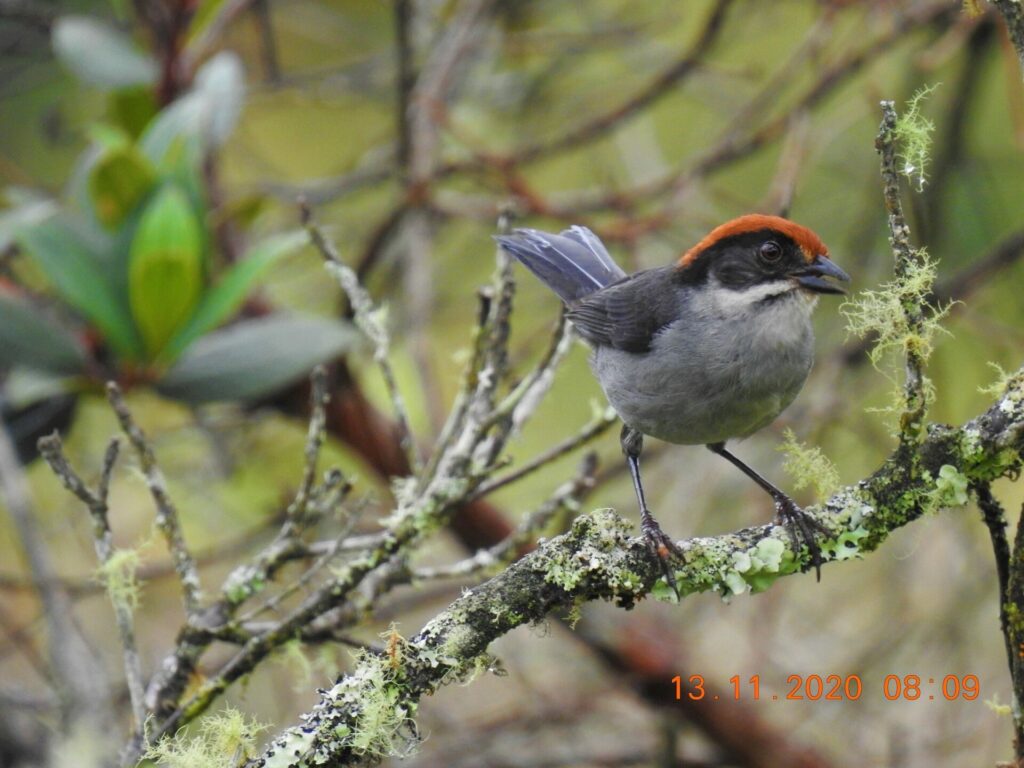A new land purchase of 302 acres (122 hectares) has connected Colombian cloud forests that are home to Ocelot, Oncilla, and the Antioquia Brushfinch, a Critically Endangered bird once known only from museum specimens.
The expansion of the Guanacas Reserve in the Colombian Andes was backed by our Action Fund supporters and made possible by the foresight, knowledge and hard work of World Land Trust (WLT) partner Fundación Guanacas Bosques de Niebla. This latest Action Fund victory will expand the reserve to 1,700 acres (687 hectares) – that’s the size of Gibraltar!
The reserve extension brings a major reprieve to a wealth of endangered life, none more so than the endemic Antioquia Brushfinch. First identified from three museum specimens in 1971, this songbird with its striking rusty crown was not seen alive until 2018. Lying on the edge of extinction, its population is thought to number fewer than 50 individuals, restricted entirely to a small area of northwestern Colombia.
WLT began supporting the Guanacas Reserve in 2019, during which time communities and researchers – led by the American Bird Conservancy – were rallying to save the Antioquia Brushfinch. This culminated in some fantastic news last year, when the species was spotted in the Guanacas Reserve for the first time.
The new land purchase provides the few remaining Antioquia Brushfinches with “territory free from the threat of habitat loss, being a sanctuary of biodiversity in perpetuity,” says José Rodrigo Castaño Díaz, Founder of Fundación Guanacas, who adds: “Expanding the reserve is the best strategy to guarantee their reproduction and improve their population.”
The Guanacas Reserve is made up mostly of cloud forest, with some areas of former pastureland. Image: Fundación Guanacas
The support WLT provided to the Guanacas Reserve could not have come at a better time. Productive activities, such as livestock and agriculture, are the main drivers behind the habitat loss that blights the region and the “greatest threat” to its biodiversity, says José. These activities not only deforest the land but degrade it as well, affecting the soil, water and habitat quality that all forms of life depend on.
Meanwhile, Guanacas Reserve residents like the Ocelot and Oncilla are threatened by the illegal wildlife trade, while the Puma comes into conflict with local communities who fear the predator may prey upon their cattle. Fundación Guanacas staff are working on strategies to improve these human-wildlife relationships, while the newly purchased land will consolidate an important biological corridor for the wildcats, who as top predators play a key role in the ecosystem.
This Oncilla was rescued from the site of a large construction project before being released safely into the Guanacas Reserve. Image: Fundación Guanacas / Juan Carlos Macías
A reserve of special significance
Fundación Guanacas is one of WLT’s newest partners, and as with all the projects we support, the land they protect boasts outstanding biodiversity value.
Perched between 1,900 and 2,700 metres above sea level, the Guanacas Reserve protects one of the last remnants of lower montane wet forest. Strongly influenced by climatic phenomena – it is a cloud forest after all! – the reserve also performs crucial ecological functions by improving soil fertility, storing carbon, reducing the risk of erosion and landslides, and acting as a reservoir for the surrounding area.
Maintaining the ecological integrity of such an ecosystem is paramount. One of the ways this will be achieved in the expanded reserve is through the connection of forest fragments – greatly boosting the survival chances for threatened species by allowing for greater mobility and a larger habitat.
Tropical montane cloud forests play a role in regulating hydrological cycles. Image: Fundación Guanacas / Juan Carlos Macías
By acting to preserve these uniquely valuable Andean cloud forests, Fundación Guanacas’ land purchase will bolster the conservation prospects of many nationally and regionally endemic species.
Alongside the flagship brushfinch, the reserve extension will benefit the resident Endangered magnolia tree Magnolia yarumalensis, a spotted rodent known as the Mountain Paca, the Critically Endangered toad Atelopus sernai, the distinctive Golden-fronted Whitestart, and more than 90 species of orchid.
Golden-fronted Whitestart plumage varies; some have a white face contrasted with a golden crown. Image: Fundación Guanacas / Juan Carlos Macías
To ensure a safer, healthier home for all, Fundación Guanacas plan to restore various degraded areas in the reserve through native plant species, boosting connectivity between the site and the Santa Rosa de Osos municipal reserve. Our partner is also setting aside a 23-acre site of former pastureland to use as a base for their environmental education, ecotourism and community outreach initiatives.
After the reserve expansion was confirmed, Juan Carlos Macías, Lead Ranger for Fundación Guanacas, described WLT’s support as “a voice of encouragement for our conservation work that inspires us to continue forward. It strengthens us, and allows us to take on new challenges … This support allows us to be an example for other initiatives of civil society, teaching that conservation is everyone’s responsibility and commitment, even more so in times of uncertainty and global crisis.”

